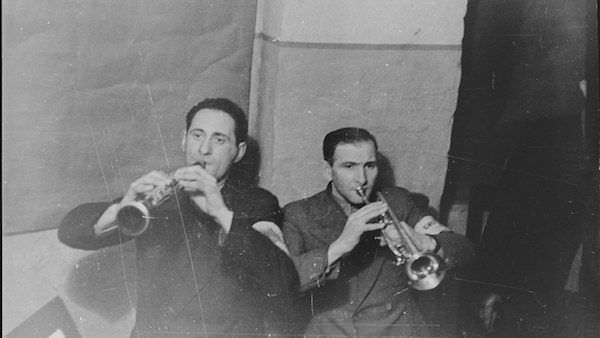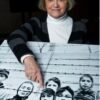
Kovno Ghetto orchestra George Kadish / Zvi Kadushin / U
On the night of March 27-28, 1944, at the height of the “Kinder Aktion” in which 1,200 children and elderly men and women from the Kovno Ghetto were murdered and the commanders of the local Jewish police force executed, three prisoners from the ghetto were sent on a special mission. They snuck into the empty home of one of the police officers, who had been arrested and killed, and removed two tin boxes.
One of the men, Azriel Levy, later described the dramatic event: “At night we dug two large holes and lowered the boxes into them. Heavy snow was falling that night, and covered the area of the holes and covered the footprints.”
The ghetto archives were hidden in the boxes, a real historical treasure containing some 30,000 pages. Twenty years later, in 1964, while the foundations were being dug for a new building, the archive was discovered by accident. But only after the fall of the Soviet Union did parts of the archive begin to be published in the West.

Rami Neudorfer, who in the past was a high-tech executive and before that a lieutenant colonel in the Israel Defense Forces, studied this unique archive in recent years as part of his studies in Jewish history at Tel Aviv University, where he is now writing his Ph.D. thesis under the direction of Prof. Havi Dreifuss on day-to-day life in the Kovno Ghetto. Kovno, now known by its Lithuanian name Kaunus, is the second largest city in Lithuania.
Among the reports on the activities of the Jewish ghetto police (Juedischer Ordnungsdienst) and the Council of Elders of the Kovno Jewish Ghetto Community (Aeltestenrat der Juedischen Ghetto Gemeinde Kauen), which describe daily life in the ghetto, Neudorfer was drawn to documents of a very different type. These included music, programs and invitations to concerts of the police orchestra. That is how, without intending to do so, Neudorfer found an important and fascinating piece of history that no one had investigated before him.
His discovery took him on a journey through the archive in the footsteps of the partly secret orchestra, which managed to hold concerts at the depths of the Holocaust. Now Neudorfer is working hard on the planning for a major event: A recreation of one of the orchestra’s concerts.
The Jewish ghetto police orchestra was established in the summer of 1942. The members were Jewish musicians from the ghetto, who at least on paper were police officers. They played under the direction of conductor and well-known musician Michael (Misha) Hofmekler. The concerts were performed in the police station, which was set up in the building that housed the Slabodka Yeshiva before the war. “There were those who criticized holding the concerts in a holy place, while others said the exact opposite,” said Neudorfer.
He thinks that the orchestra was established in order to provide work for outstanding musicians and add to the cultural life of the ghetto. “Dozens of concerts were held in the ghetto, most of them classical [music]. At some, representatives of the German authorities were present, including SS officers,” says Neudorfer.
He found evidence of the internal Nazi power struggles in which SS officers were accused of enjoying the Jewish concerts. Among the Jewish community, in particular among the underground, there were voices that objected to the concerts too – for the exact opposite reasons.
“Among the residents of the ghetto there were those who said: ‘You are hosting our murderers at these concerts.’ But the orchestra was important in raising the morale of the Jews in the ghetto,” Neudorfer says.

At the end of March 1944, with the arrest of all members of the Jewish police, the members of the orchestra were separated out and not arrested. After the entire ghetto was eliminated, they were sent to the Dachau concentration camp in Germany and played there. Many of them survived the Holocaust and appeared in concerts in the displaced persons camps in Germany after the war.
In the Jewish police archive in the ghetto, Neudorfer also found documentation of the orchestra’s activities with the underground. It turns out that alongside the classical music concerts, which the SS officers also enjoyed, the orchestra played underground concerts too, which included Jewish and Zionist music in Hebrew and Yiddish.

One such concert took place on November 1, 1942, during the swearing-in ceremony for police officers of the ghetto police force held in the yeshiva. Documents from the archive tell how the policemen were called in order to a table where they signed the oath. At the same time the orchestra played national songs, providing the entire ceremony with the atmosphere of a national celebration.
Later the order was given to march out and the orchestra thundered out the song “B’shvuv Hashem” (When God returns), whose words are from Psalm 126 of the Book of Psalms but whose tune was not well-known. “The sounds of this song set the police officers on fire as well as some of the gathered crowd. The hidden emotions burst out, the hearts and minds lit up,” states one of the documents in Yiddish from the archive describing the event, whose translation will appear in a book to be published this year on the Kovno Ghetto by the Yad Vashem Holocaust memorial center.
“Despite our senses, which have been blunted because of all the tragedies, as if all of them were eliminated, from the throats of hundreds of Jews burst forth singing with the orchestra: ‘When the Lord brought back those that returned to Zion, we were like unto them that dream. Then was our mouth filled with laughter, and our tongue with singing … They that sow in tears shall reap in joy.’
“With tears in their eyes, the audience sang the words of the prophecy of freedom and liberation, of fulfillment of our dreamed-for and holiest hopes, which today are nothing but fantasy and tomorrow can turn into reality. Accompanied by the music of the orchestra and singing of the policemen and those gathered, and under the fierce impression of the demonstration of national will, they dispersed,” continues the document.
It is not known who wrote these words, which were found in the archive. Neudorfer located the program for the event in the archive, written in Yiddish. Alongside the musical selection “For you are dust,” with its great symbolic significance, the concert included a “Jewish mourning song,” another unknown song entitled “Eli, Eli” (My God, My God) written by a man named Gurwitch, and the Kol Nidrei prayer from Yom Kippur with a melody written by the German Jewish composer of cantorial music Louis Lewandowski.
Another concert was held on July 3, 1943. This time the excuse was the anniversary of the operation of the vocational schools in the ghetto. “The concert was long and complex, and included sections in which the police orchestra played, the children’s choir, solo selections of young artists, reading selections and dramatized selections,” says Neudorfer.
A third concert documented in the archive was held on July 24, 1943. This was a secret and special concert conducted on the anniversary of the death of Jewish poet and author Hayim Nahman Bialik, and the day after the anniversary of the death of Theodor Herzl. All activists of the Zionist parties that operated in the ghetto attended the concert, which was completely in Hebrew. “The songs reflected the range of the movements in Zionism,” says Neudorfer. The songs included those of both the socialist workers movements and the Revisionist Beitar.
The concert also included Yemenite tunes, which Neudorfer has yet to identify. There were no speeches given, though a poem of Bialik’s named “Davar” was read out. “The poem expressed the atmosphere of those days very well: the persecuted community of the Kovno Ghetto, whose members were aware of the sword hanging over their heads,” says Neudorfer.
Moving testimony of the existence of this concert also appears in the diary of Avraham Tory (Golub), the secretary of the community’s Jewish Council of Elders, who managed to escape the ghetto and survived. In his diary, which was published in 1982 as “Surviving the Holocaust: The Kovno Ghetto Diary,” Tory writes that after two years of being imprisoned in the ghetto the Zionist comrades from all movements and directions were hungry for a “living word,” a Zionist environment, the sounds of song dear to their hearts. There was a need to do something, gather together finally, to hear a Zionist idea.
“In the end they decided to hold a concert that was all in Hebrew: Hebrew music, Hebrew poetry, Hebrew readings. The police orchestra took on the task immediately to learn the music, the melodies in Herzl’s memory, the psalm, tunes and works from the Land of Israel,” wrote Tory in his diary.
The concert, which played to a full hall, was a great success and the atmosphere was festive, wrote Tory. For the first time in three years friends saw each other in a mass get-together. There were pictures of Herzl and Bialik on the walls, and the crowd applauded vigorously, he says.
At the end of the concert the audience stood on its feet and sang “Hatikva” along with the orchestra. Tory describes the emotional event: “The sounds of ‘Hatikva’ were powerful and were carried far away to the mountains of Judea and valleys of Sharon, to the Mediterranean, the shores of the Jordan, to Mount Scopus, the cities and villages, moshavim and kibbutzim in the Jezreel Valley and the Galilee. The sounds carried their greetings from Kovno to Israel and returned at the same time to the hall with the good tidings of the redemption that would arrive soon. Everyone’s heart was filled with rejoicing and tears poured from their eyes. Hope flowed from the depths of the soul, courage and a cry out loud: ‘We have not yet lost our hope,’ it was a great day for us today,” wrote Tory.
Alongside the documents in the archive, a number of pictures of the orchestra and its members survived too. This was due to the efforts of George Kadish (Zvi Hirsch Kadushin), a Jewish photographer who was imprisoned in the ghetto and secretly took thousands of pictures portraying day-to-day life in the ghetto.
Neudorfer is now trying to complete his work on the police orchestra and locate all the music it played. “It is my fantasy that the [Israel] police orchestra or the IDF orchestra will appear this summer with the repertoire of the ghetto police orchestra. In recreating this concert, I want to salute the memory of the heroes of the Kovno ghetto,” he says.
Originally published HERE.





